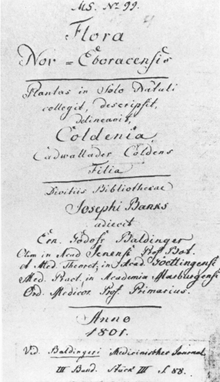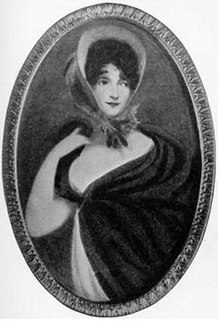Jane Colden

Jane Colden Farquhar (born March 27, 1724 in New York City , † March 10, 1766 there ) was an American botanist . She was the first woman to work as a botanist in America and is best known for her untitled manuscript describing the flora of the New York area.
life and work
Colden was born the fifth child of Alice Christy Colden and the doctor Cadwallader Colden , who trained at the University of Edinburgh and became involved in the politics and management of New York in 1718 after his arrival from Scotland. She was raised at home and her father gave her a botanical training according to the system of plant classification newly developed by the Swedish botanist Carl von Linné and translated his work. As a result, she learned the English translations of many Latin botanical terms and she quickly mastered the system of plant classification. She sketched plants, made ink prints of leaves and also mastered the English descriptions of plants.
Correspondence and exchanges with other botanists
Due to the lack of schools and gardens in the area, her father wrote to the botanist Peter Collinson asking him where he would get the best pruning of plants so that she could continue her study of botany. Her father not only procured her literature and pruning plants, but also introduced her to the great botanists of America and Europe. In the 1750s she corresponded with important botanists, including John Ellis and Peter Collinson in London and Charles Alston and Robert Whytt in Edinburgh . She corresponded with the Dutch botanist John Frederik Gronovius and the botanist Carl von Linné, who had been her main inspiration. She met the American naturalist Alexander Garden and the American botanists John Bartram and William Bartram when they stopped at their estate during their expedition through the Catskill Mountains . From 1753 to 1758, she cataloged the New York flora, collected specimens and information on more than 400 plant species from the lower Hudson River Valley and classified them according to the new system. She developed a technique for making ink prints from leaves and was also a skilled illustrator who made ink drawings. She classified and sketched all of the plants that grew on her family property. She documented each plant down to the smallest detail and accompanied each entry with a pressure abrasion or a line drawing of the relevant shoot. Unlike most male botanists of the time, she noted the practical uses of each plant in medicine and cooking, and even attributed these details to the country folk or the local people who taught them. She participated in the Natural History Circle, where she exchanged seeds and plants with other plant collectors in the American colonies and Europe. One of her descriptions of a new plant, which she herself named Fibraurea, was forwarded to Carl von Linné with the suggestion that it should be named Coldenella, but von Linné refused and named it Helleborus (now Coptis groenlandica).
In 1756, she discovered the plant now known as Triadenum virginicum . Collinson, Garden and Ellis were Fellows of the Royal Society and asked von Linnaeus to name a plant after her. Despite this influential support, no plant was named in her honor. The genus Coldenia is named after its father
Marriage and death
In 1759 she married William Farquhar, a Scottish physician who practiced in New York City. Farquhar, a friend of Alexander Garden, knew some of the Scottish botanists who had corresponded with his wife. Although there are few records of Colden's personal life, she is known to have established her reputation as a botanist in the 1750s. After the marriage, she is said to have looked after her only child, who died in 1766.
recognition
One of her most important contributions to botany, her description of the gardenia , was included in a publication in Edinburgh entitled Essays and Observations. She was the first scientist to describe the gardenia and named it after Alexander Garden. Her work on the classification of plants was published in a Scottish journal in 1770, four years after her death. During the War of Independence, her notes and drawings were rescued by a military officer, brought to England, and given to the botanist Sir Joseph Banks , who gave his collection of books to Natural History Museum in London when he died in 1820.
In 1957, the Jane Colden Memorial Garden was laid out in Orange County at Knox's Headquarters State Historic Site . The volunteers only planted the native species Colden described in her book. However, by the early 1990s, the garden was as good as deserted. In 2014, a retired local superintendent revived the garden.
The author abbreviation Colden is used to indicate her as the author when a botanical name is quoted.
literature
- James, Edward T., and others: Notable American Women, 1607-1950, Volume I. Cambridge, Belknap Press of Harvard University Press, 1971.
- Johnson, Allen, and others: Dictionary of American Biography. New York: Scribner, 1946-58.
- Paula Ivaska Robbins: Jane Colden: America's First Woman Botanist, 2009, ISBN 978-0916346805 .
- Gronim, SS: What Jane knew: a woman botanist in the eighteenth century. Journal of women's history, 19 (3), 2007.
- Harrison, M .: Jane Colden: Colonial American Botanist. Arnoldia, 55 (2), 1995.
- Johnson, V .: American Eden: David Hosack, Botany, and Medicine in the Garden of the Early Republic. Liveright Publishing, 2018.
- Smith, BS: Jane Colden (1724-1766) and her Botanic Manuscript. American Journal of Botany, 75 (7), 1988.
- HW Rickett, Elizabeth Hall: Botanic Manuscript of Jane Colden, 1724-1766, 1963.
- James Britten: Jane Colden and the Flora of New York, Journal of Botany, British and Foreign 33, 1895.
- Anna Murray Vail: Jane Colden, an Early New York Botanist, Contributions from the New York Botanical Garden 4, 1966-1967.
- Marilyn Bailey Ogilvie: Jane Colden, in Women in Science: Antiquity through the Nineteenth Century, 1986
- Raymond Phineas Stearns: Science in the British Colonies of America, 1970, ISBN 978-0252001208 .
- Margaret W. Rossiter: Women Scientists in America before 1920, 1998, ISBN 978-0801857119 .
Web links
- biography
- Short biography in JSCNHM
- Jane Colden: America's First Female Botanist
- Botanical manuscript by Jane Colden 1724-1766
- Centuries Later, America's First Female Botanist Lives On in a Community Garden
- International Plant Names Index
| personal data | |
|---|---|
| SURNAME | Colden, Jane |
| ALTERNATIVE NAMES | Colden Farquhar, Jane (married name) |
| BRIEF DESCRIPTION | American botanist |
| DATE OF BIRTH | March 27, 1724 |
| PLACE OF BIRTH | New York City |
| DATE OF DEATH | March 10, 1766 |
| Place of death | New York City |


